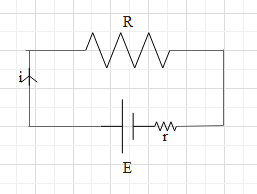
For a cell terminal potential difference is 2.2 volt when circuit is open and reduces to 1.8 volt when cell is connected to an external resistance of 5 ohm. What is the internal resistance of the cell?
Answer
579.3k+ views
Hint: Draw the corresponding circuit diagram when the cell is connected across the resistance 0f 5 ohms. Shown the internal resistance r in series. It is given that the potential difference across 5 ohms is 1.8V. Hence, calculate the current using ohm’s law. Then by using ohm’s law calculate the internal resistance.
Formula used:
V=iR
Complete step by step answer:
Cell is a device that is used to create a potential difference in the circuit and thus there is flow of charges in the circuit. We define emf for a cell.
When the circuit is open and there is no current, the potential difference across the cell’s terminal is equal to emf E.
When the cell is connected across a resistance the cell creates a potential difference equal to E across the resistance (R) and due the potential difference, there is current in the circuit. The value of the current is $i=\dfrac{E}{R}$.
However, every cell has a self resistance called internal resistance (r). Therefore, when a cell is connected across the resistance, the internal resistance contributes to the net resistance and thus the current in the circuit is less than then $\dfrac{E}{R}$.
It is given that E=2.2V.
When the cell is connected across the resistance of 5 ohms, The potential difference across 5 ohms is 1.8V.
Let us make the diagram of the above circuit. The current in the circuit be i.

Let the potential difference across 5 ohms resistance be V. Then according to Ohm’s law, V=iR.
This implies, $1.8=i(5)$
$\Rightarrow i=\dfrac{1.8}{5}=0.36A$.
Therefore current in the circuit is 0.36 A.
The potential difference that should have been created across the resistance of 5 ohms is 2.2V. However, due to the internal resistance, the potential difference across the resistance is 1.8V. That means the potential difference across r is 2.2-1.8=0.4V.
The current flowing through r is 0.36A.
Again use Ohm’s law.
Hence, we get
$0.4=0.36r$
$\Rightarrow r=\dfrac{0.4}{0.36}=1.11ohms$
Therefore, the internal resistance of the cell is 1.11 ohms.
Note:
Note that internal resistance of a cell is inside the cell though in the diagram it is shown outside the cell. The internal resistance is the same as a normal resistance and takes up some potential difference. It is the same as connecting a resistance r in series to an ideal cell.
Formula used:
V=iR
Complete step by step answer:
Cell is a device that is used to create a potential difference in the circuit and thus there is flow of charges in the circuit. We define emf for a cell.
When the circuit is open and there is no current, the potential difference across the cell’s terminal is equal to emf E.
When the cell is connected across a resistance the cell creates a potential difference equal to E across the resistance (R) and due the potential difference, there is current in the circuit. The value of the current is $i=\dfrac{E}{R}$.
However, every cell has a self resistance called internal resistance (r). Therefore, when a cell is connected across the resistance, the internal resistance contributes to the net resistance and thus the current in the circuit is less than then $\dfrac{E}{R}$.
It is given that E=2.2V.
When the cell is connected across the resistance of 5 ohms, The potential difference across 5 ohms is 1.8V.
Let us make the diagram of the above circuit. The current in the circuit be i.

Let the potential difference across 5 ohms resistance be V. Then according to Ohm’s law, V=iR.
This implies, $1.8=i(5)$
$\Rightarrow i=\dfrac{1.8}{5}=0.36A$.
Therefore current in the circuit is 0.36 A.
The potential difference that should have been created across the resistance of 5 ohms is 2.2V. However, due to the internal resistance, the potential difference across the resistance is 1.8V. That means the potential difference across r is 2.2-1.8=0.4V.
The current flowing through r is 0.36A.
Again use Ohm’s law.
Hence, we get
$0.4=0.36r$
$\Rightarrow r=\dfrac{0.4}{0.36}=1.11ohms$
Therefore, the internal resistance of the cell is 1.11 ohms.
Note:
Note that internal resistance of a cell is inside the cell though in the diagram it is shown outside the cell. The internal resistance is the same as a normal resistance and takes up some potential difference. It is the same as connecting a resistance r in series to an ideal cell.
Recently Updated Pages
A man running at a speed 5 ms is viewed in the side class 12 physics CBSE

The number of solutions in x in 02pi for which sqrt class 12 maths CBSE

State and explain Hardy Weinbergs Principle class 12 biology CBSE

Write any two methods of preparation of phenol Give class 12 chemistry CBSE

Which of the following statements is wrong a Amnion class 12 biology CBSE

Differentiate between action potential and resting class 12 biology CBSE

Trending doubts
What are the major means of transport Explain each class 12 social science CBSE

Which are the Top 10 Largest Countries of the World?

Draw a labelled sketch of the human eye class 12 physics CBSE

How much time does it take to bleed after eating p class 12 biology CBSE

Explain sex determination in humans with line diag class 12 biology CBSE

Explain sex determination in humans with the help of class 12 biology CBSE




